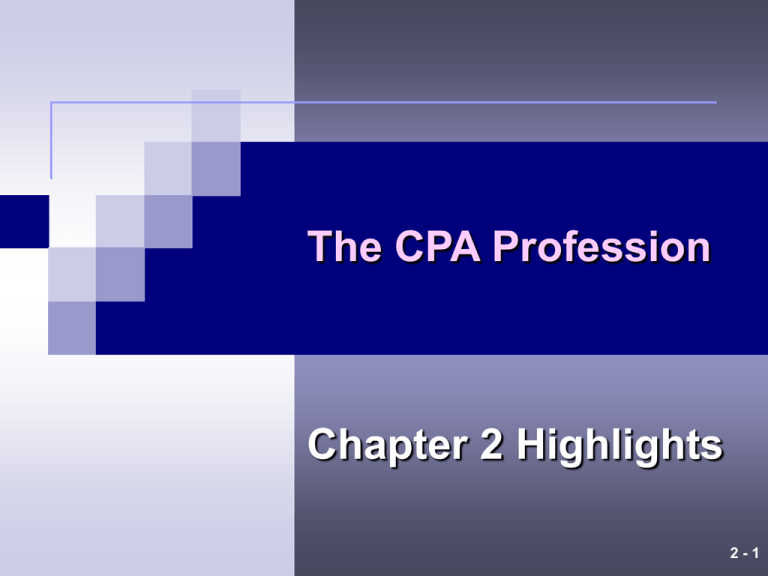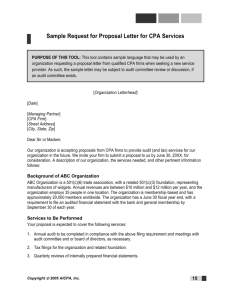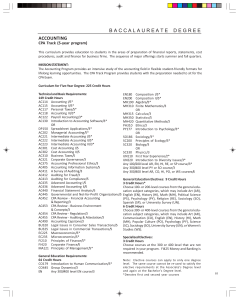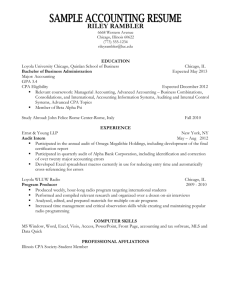Chapter 2 – The CPA Profession
advertisement

The CPA Profession Chapter 2 Highlights 2-1 Certified Public Accounting Firms The legal right to perform audits is granted to CPA firms by regulation of each state. CPA firms also provide many other services to their clients, such as tax and consulting services. 2-2 Certified Public Accounting Firms Big Four international firms National firms Regional and large local firms Small local firms 2-3 Certified Public Accounting Firms The four largest CPA firms in the United States are called the “Big Four” international CPA firms. These four firms have offices in most major cities in the United States and in many cities throughout the world. 2-4 Activities of CPA Firms Accounting and bookkeeping services Tax services Management consulting services 2-5 Hierarchy of a Typical CPA Firm Staff Level Experience Typical Responsibilities Staff assistant Senior or in-charge auditor 0-2 years Performs most of the detailed audit work 2-5 years Responsible for the audit field work, including supervising staff work 2-6 Hierarchy of a Typical CPA Firm Staff Level Experience Typical Responsibilities Manager Partner Helps the plan, manages 5-10 years the audit, reviews work, and works with the client 10+ years Reviews audit work and makes significant audit decisions 2-7 AICPA The AICPA sets professional requirements for CPAs, conducts research, and publishes materials on many different subjects related to accounting, auditing, attestation and Assurance services, management Consulting services, and taxes. 2-8 Establishing Standards and Rules 1. Auditing standards (Historically) 2. Compilation and review standards 3. Other attestation standards 4. Consulting standards 5. Code of Professional Conduct 2-9 Other AICPA Functions Writes and grades the CPA examination Supports research by its own staff and provides grants to others Publishes a variety of materials. Provides seminars and education in a variety of subject matters 2 - 10 General Standards 1. The audit is to be performed by a person or persons having adequate technical training and proficiency as an auditor. 2. In all matters relating to the assignment, an independence in mental attitude is to be maintained by the auditor or auditors. 3. Due professional care is to be exercised in the planning and performance of the audit and the preparation of the report. 2 - 11 Standards of Field Work 1. The work is to be adequately planned and assistants, if any, are to be properly supervised. 2. A sufficient understanding of internal control is to be obtained to plan the audit and to determine the nature, timing, and extent of tests to be performed. 3. Sufficient competent evidential matter is to be obtained through inspection, observation, inquiries and confirmations to afford a reasonable basis for an opinion regarding the financial statements under audit. 2 - 12 Standards of Reporting 1. The report shall state whether the financial statements are presented in accordance with generally accepted accounting principles. 2. The report shall identify those circumstances in which such principles have not been consistently observed in the current period in relation to the preceding period. 2 - 13 Standards of Reporting 3. Informative disclosures in the financial statements are to be regarded as reasonably adequate unless otherwise stated in the report. 4. The report shall contain an expression of opinion regarding the financial statements, taken as a whole. 2 - 14 Relationship Between GAAS and PCAOB Auditing Standards The term generally accepted auditing standards is no longer used for public company audits. The term GAAS continues to be used for audits of private companies. Public company audits refer to PCAOB auditing standards. 2 - 15 Statements on Auditing Standards The 10 generally accepted auditing standards are too general to provide meaningful guidance. SASs interpret the 10 generally accepted auditing standards and are the most Authoritative references available to auditors. 2 - 16 Elements of Quality Control Standards Independence, integrity, and objectivity Personnel management Acceptance and continuation of clients and engagements Engagement performance Monitoring 2 - 17 CPAs Encouraged to Conduct Themselves at a High Level CPA examination Quality control GAAS and interpretations Conduct of CPA firm personnel Peer review PCAOB and SEC Code of Professional Conduct Continuing education requirements Legal liability Division of CPA firms 2 - 18 Next Class: Background and nature of the Sarbanes-Oxley Act. It’s effect on the CPA profession Role of the Public Company Accounting Oversight Board (PCAOB) 2 - 19





